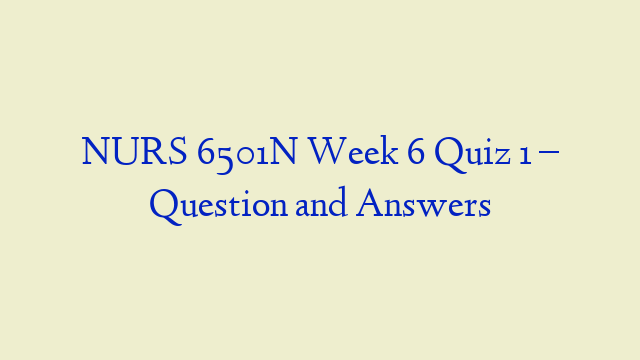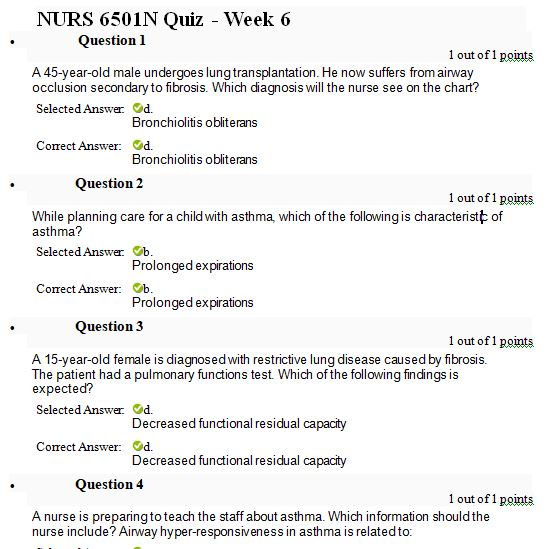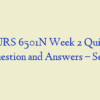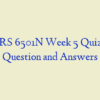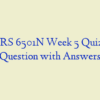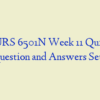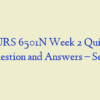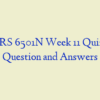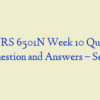Description
NURS 6501N Week 6 Quiz – Question and Answers
- A 45-year-old male undergoes lung transplantation. He now suffers from airway occlusion secondary to fibrosis. Which diagnosis will the nurse see on the chart?
- While planning care for a child with asthma, which of the following is characteristic of asthma?
- A 15-year-old female is diagnose with restrictive lung disease caused by fibrosis. The patient had a pulmonary functions test. Which of the following findings is ……?
- A nurse is preparing to teach the staff about asthma. Which information should the nurse include? Airway hyper-responsiveness in asthma is related to:
- An 11-year-old female presents with a low-grade fever and cough. She is diagnose with atypical pneumonia. What type of pneumonia does the nurse suspect the patient is experiencing?
- A 65-year-old male recently had a cerebrovascular accident that …..in dysphagia. He now has aspiration of gastric contents. The nurse assesses the patient for which complication?
- A 50-year-old male with a 30-year history of smoking was ……with lung cancer. He was previously exposed to air pollution, asbestos, and radiation at his job. Which of the following should the nurse realize had the greatest impact on the development of his cancer?
- A 53-year-old male with a 20-year history of smoking is …..with emphysema. When a staff member asks why the patient’s airways are ….., how should the nurse respond? The airways are ….because of:
- A nurse recalls asthma is classified by nurs 6501n week 6 quiz
- A 28-year-old male reports to his primary care provider that he has had a cold for a week and is coughing up bloody secretions. When giving report, what term should the nurse use to describe this condition?
- A 57-year-old male presents with cough, sputum production, dyspnea, and decreased lung volume. He is diagnose with pneumoconiosis. When taking the patient’s history, which finding is the most probable cause of his illness?
- A 30-year-old male is …..in a motor vehicle accident and sustains trauma to the lungs and chest wall. He experiences respiratory failure. Which of the following lab values would the nurse expect?
- A 60-year-old female with a 25-year history of smoking is …with emphysema. She has an increased anterior-posterior chest diameter. The nurse attributes this finding to:
- When the pulmonologist discusses the condition in which a series of alveoli in the left lower lobe receive adequate ventilation but do not have adequate perfusion, which statement indicates the nurse understands this condition? When this occurs in a patient it is called:
- A 20-year-old male presents to his primary care provider reporting difficulty breathing when lying down. What term should the nurse use to document this condition?
- A 10-year-old male is brought to the ER with prolonged bronchospasm and severe hypoxemia. The most likely diagnosis on the chart is:
- Which patient would the nurse assess for paroxysmal nocturnal dyspnea (PND)? A patient with nurs 6501n week 6 quiz
- A 2-week-old female presents with fever, cough, respiratory distress, and empyema. Which of the following is the most likely diagnosis the nurse will observe on the chart?
- If an individual with respiratory difficulty were retaining too much carbon dioxide, which of the following compensatory responses would the nurse expect to be initiated?
- A 7-month-old male presents with cystic fibrosis (CF) accompanied by a failure to thrive and frequent, loose, and oily stools. Sweat testing reveals increased chloride. Which of the following should the nurse observe for that would accompany this disease?
- A 14-year-old male is experiencing an asthma exacerbation. When reviewing the lab results, which of the following cells in the submucosa promote this inflammatory response and will be elevated?
- A 30-year-old female received a severe head injury in a motor vehicle accident. She is now experiencing respiratory abnormalities …..by alternating periods of deep and shallow breathing with periods of apnea. What term should the nurse use when charting this condition?
- A 53-year-old male with a 20-year history of smoking is …..with emphysema. When the nurse is …..what causes this, what is the nurse’s best response? Changes in his lungs are …..
- A nurse is preparing to teach the staff about asthma. Which information should the nurse include? Airway obstruction contributing to …..airflow resistance and hypoventilation in asthma is caused by:
- A 50-year-old male presents with hypotension, hypoxemia, and tracheal deviation to the left. Tests reveal that the air pressure in the pleural cavity exceeds barometric pressure in the atmosphere. Based upon these assessment findings, what does the nurse suspect the patient is experiencing?
- A 9-year-old male ….influenza. Which of the following complications is of greatest concern to the nurse?
- A 13-year-old female is ….with asthma. Which of the following should the nurse teach the patient to recognize as part of an asthmatic attack?
- A young patient is admitted to the pediatric unit with cystic fibrosis (CF) exacerbation. The nurse monitors the patient closely because the main cause of death in a child with CF is:
- A 50-year-old diabetic male did not take his medication and is now in metabolic acidosis. He is experiencing Kussmaul respirations. What type of breathing will the nurse observe upon assessment?
- A 6-month-old female presents with rhinorrhea, cough, poor feeding, lethargy, and fever. She is diagnosed with bronchiolitis. Which of the following will the nurse most likely observe on the culture report?

